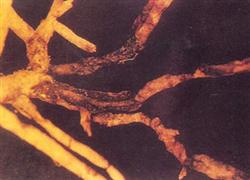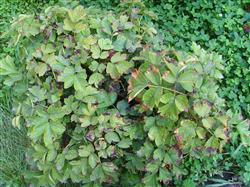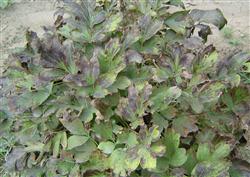How to raise peonies: what is peony purple feather disease?

What is peony purple feather disease? What harm does purple stripe feather disease have to peony? Also ask friends to help introduce the harm of purple feather disease of peony: commonly known as purple or black root rot, is a common fungal disease of peony. The incidence of old plants and continuous cropping for many years is higher, which not only harms forest fruit trees and crops, but also harms trees and crops. The infection source is the mycelium living in the soil. Through contact infection, the harm process is that the young root is infected first, and gradually extends to the lateral root, main root and root neck. The diseased root appears yellow-brown at first and becomes dark purple or black or wet rot in severe cases. There is a layer of cotton-like mycelium on the surface of the diseased root. In the later stage, the surface of the diseased root is completely rotten, but it is still intact in the periphery of the xylem and can move up and down. The characteristic of this disease is that the damage period is long, and the sick peony will not die immediately. It will take three to five years or more. The growth potential of the damaged plant weakened, yellowed, and the leaves became smaller, blooming in large and small years, and in severe cases, some branches or the whole plant withered. The reason is that the old root is rotten, there is no new root, and the growth is hindered. Once the cotton-like mycelium appears at the root neck, it shows that most of the underground root plants have rotted, and the plant will die quickly. Prevention and control methods of peony purple plume disease: first, strictly disinfect seedlings and soil and soak the roots with 20% lime water for half an hour, or 100 times or Bordeaux solution for 1 hour, and then soak the roots with 1% copper sulfate solution for 3 hours. Then wash it with clean water and plant it. Soil disinfection, can be 2.5% per mu of Sailisan powder 5-7.5 kg or pentachloronitrobenzene powder 2.5-5 kg, or sulfur powder 10-20 kg, turn over the soil. Small area planting, can carry out seedbed or tree hole disinfection, with 30% liquid agent "soil bacteria elimination" 500 times liquid spray, the dosage is 3 liters per square meter. Second, the main cause of root rot caused by strengthening soil water and fertilizer management is mainly caused by soil infection caused by the application of organic fertilizers such as human manure and urine which are not fully mature and fermented. Therefore, to strengthen the soil water and fertilizer management, the main measures are as follows: 1. Increase the application of potassium fertilizer to promote the growth of new roots. During the growing period, 0.1-0.2% potassium dihydrogen phosphate can be used for foliar spraying, or potassium sulfate or potassium chloride (not used in saline-alkali land) can be added during fertilization, with a dosage of 5-7.5 kg per mu. 2, reasonable ploughing and winter turning, so that the mature soil layer of the peony garden is often maintained at about 25 to 30 cm, preventing soil consolidation, keeping the soil loose, and having good water and air permeability. 3. Avoid raw fertilizer and heavy fertilizer. Human feces and urine are rarely used or not used as much as possible, such as the application of organic fertilizers such as human feces and urine, which must be fully ripened and fermented. 4. Timely control of underground pests. The root plants bitten by grubs are easy to be infected with root rot. Therefore, every early spring, it is necessary to spray trichlorfon 800x liquid or phoxim 1000 times liquid in time. 5. Properly grasp the watering times and amount of peony, especially in the early spring and late summer mycelium activity period, when the soil water content is not less than 60%, as little or no watering as possible, in order to reduce infection. Third, root irrigation treatment for seriously affected plants can be dug up and burned, or disinfected and replanted after removal of the diseased roots. The plants with primary or mild disease can be treated by ditching and root irrigation. The following drugs have a certain curative effect on root rot, and you can choose to use: Baume 1 degree stone sulfur mixture (2.5-7.5kg / plant); 200-500fold copper sulfate solution (5-7.5kg / plant); Tuijute wettable powder 500,800fold solution (1.5kg-2.5kg / plant); 1000-fold solution of 70% methyl topiramate (1.5kg / plant). In early spring or late summer, 3-5 radial trenches were dug around the trunk of the plant, which were as long as the crown, 20-30 cm wide and 30 cm deep. It was better to expose the roots and seal the soil after irrigation. Fourth, root drying and trenching isolation will remove the soil around the diseased plant and expose the diseased root to the air, which can be carried out from early spring to the end of autumn by sunlight exposure and ventilation to reduce and restrain the development of the disease. In addition, between diseased and healthy plants, depending on the depth of root distribution, trenches with a depth of 60-80 cm were dug to prevent and block mycelium extension from causing contact infection. Fifth, in order to prevent the spread and infection of peony root rot, pine and cypress should be planted around the peony garden, but poplar, willow, locust and white wax should not be planted. Click to get more peony planting techniques click to get more flower planting techniques
- Prev

How to raise peonies: what is peony gray mold?
What is Botrytis cinerea of peony? What harm does Botrytis cinerea do to peony? Also ask friends to help introduce the harm of Botrytis cinerea: peony is damaged by Botrytis cinerea during the whole growth period, and the disease is the most common from June to July every year. The stem base of the seedlings was killed, showing dark green, water stains, irregular disease spots, and gradually brown.
- Next

How to raise peonies: what are the peony diseases and insect pests?
What are the peony diseases and insect pests? How to control peony diseases and insect pests? Ask netizens to help introduce and guide the main diseases and insect pests of peony are: Botrytis cinerea, brown spot, anthrax, wheel spot, branch blight, root-knot nematode disease, the following detailed introduction of the harm and control methods for netizens' reference. 1. Peony.
Related
- Fuxing push coffee new agricultural production and marketing class: lack of small-scale processing plants
- Jujube rice field leisure farm deep ploughing Yilan for five years to create a space for organic food and play
- Nongyu Farm-A trial of organic papaya for brave women with advanced technology
- Four points for attention in the prevention and control of diseases and insect pests of edible fungi
- How to add nutrient solution to Edible Fungi
- Is there any good way to control edible fungus mites?
- Open Inoculation Technology of Edible Fungi
- Is there any clever way to use fertilizer for edible fungus in winter?
- What agents are used to kill the pathogens of edible fungi in the mushroom shed?
- Rapid drying of Edible Fungi

